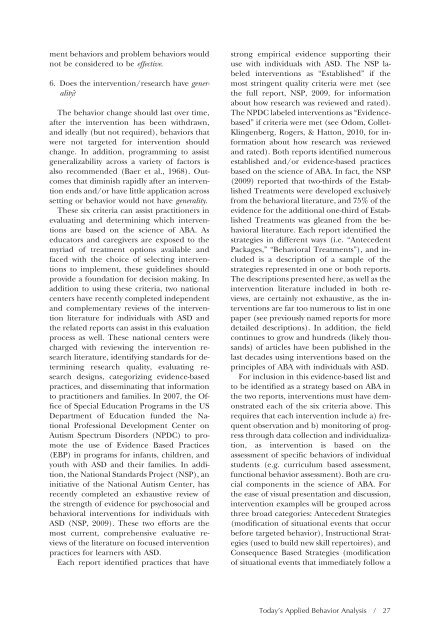Beyond Time Out and Table Time - Division on Autism and ...
Beyond Time Out and Table Time - Division on Autism and ...
Beyond Time Out and Table Time - Division on Autism and ...
Create successful ePaper yourself
Turn your PDF publications into a flip-book with our unique Google optimized e-Paper software.
ment behaviors <str<strong>on</strong>g>and</str<strong>on</strong>g> problem behaviors would<br />
not be c<strong>on</strong>sidered to be effective.<br />
6. Does the interventi<strong>on</strong>/research have generality?<br />
The behavior change should last over time,<br />
after the interventi<strong>on</strong> has been withdrawn,<br />
<str<strong>on</strong>g>and</str<strong>on</strong>g> ideally (but not required), behaviors that<br />
were not targeted for interventi<strong>on</strong> should<br />
change. In additi<strong>on</strong>, programming to assist<br />
generalizability across a variety of factors is<br />
also recommended (Baer et al., 1968). <str<strong>on</strong>g>Out</str<strong>on</strong>g>comes<br />
that diminish rapidly after an interventi<strong>on</strong><br />
ends <str<strong>on</strong>g>and</str<strong>on</strong>g>/or have little applicati<strong>on</strong> across<br />
setting or behavior would not have generality.<br />
These six criteria can assist practiti<strong>on</strong>ers in<br />
evaluating <str<strong>on</strong>g>and</str<strong>on</strong>g> determining which interventi<strong>on</strong>s<br />
are based <strong>on</strong> the science of ABA. As<br />
educators <str<strong>on</strong>g>and</str<strong>on</strong>g> caregivers are exposed to the<br />
myriad of treatment opti<strong>on</strong>s available <str<strong>on</strong>g>and</str<strong>on</strong>g><br />
faced with the choice of selecting interventi<strong>on</strong>s<br />
to implement, these guidelines should<br />
provide a foundati<strong>on</strong> for decisi<strong>on</strong> making. In<br />
additi<strong>on</strong> to using these criteria, two nati<strong>on</strong>al<br />
centers have recently completed independent<br />
<str<strong>on</strong>g>and</str<strong>on</strong>g> complementary reviews of the interventi<strong>on</strong><br />
literature for individuals with ASD <str<strong>on</strong>g>and</str<strong>on</strong>g><br />
the related reports can assist in this evaluati<strong>on</strong><br />
process as well. These nati<strong>on</strong>al centers were<br />
charged with reviewing the interventi<strong>on</strong> research<br />
literature, identifying st<str<strong>on</strong>g>and</str<strong>on</strong>g>ards for determining<br />
research quality, evaluating research<br />
designs, categorizing evidence-based<br />
practices, <str<strong>on</strong>g>and</str<strong>on</strong>g> disseminating that informati<strong>on</strong><br />
to practiti<strong>on</strong>ers <str<strong>on</strong>g>and</str<strong>on</strong>g> families. In 2007, the Office<br />
of Special Educati<strong>on</strong> Programs in the US<br />
Department of Educati<strong>on</strong> funded the Nati<strong>on</strong>al<br />
Professi<strong>on</strong>al Development Center <strong>on</strong><br />
<strong>Autism</strong> Spectrum Disorders (NPDC) to promote<br />
the use of Evidence Based Practices<br />
(EBP) in programs for infants, children, <str<strong>on</strong>g>and</str<strong>on</strong>g><br />
youth with ASD <str<strong>on</strong>g>and</str<strong>on</strong>g> their families. In additi<strong>on</strong>,<br />
the Nati<strong>on</strong>al St<str<strong>on</strong>g>and</str<strong>on</strong>g>ards Project (NSP), an<br />
initiative of the Nati<strong>on</strong>al <strong>Autism</strong> Center, has<br />
recently completed an exhaustive review of<br />
the strength of evidence for psychosocial <str<strong>on</strong>g>and</str<strong>on</strong>g><br />
behavioral interventi<strong>on</strong>s for individuals with<br />
ASD (NSP, 2009). These two efforts are the<br />
most current, comprehensive evaluative reviews<br />
of the literature <strong>on</strong> focused interventi<strong>on</strong><br />
practices for learners with ASD.<br />
Each report identified practices that have<br />
str<strong>on</strong>g empirical evidence supporting their<br />
use with individuals with ASD. The NSP labeled<br />
interventi<strong>on</strong>s as “Established” if the<br />
most stringent quality criteria were met (see<br />
the full report, NSP, 2009, for informati<strong>on</strong><br />
about how research was reviewed <str<strong>on</strong>g>and</str<strong>on</strong>g> rated).<br />
The NPDC labeled interventi<strong>on</strong>s as “Evidencebased”<br />
if criteria were met (see Odom, Collet-<br />
Klingenberg, Rogers, & Hatt<strong>on</strong>, 2010, for informati<strong>on</strong><br />
about how research was reviewed<br />
<str<strong>on</strong>g>and</str<strong>on</strong>g> rated). Both reports identified numerous<br />
established <str<strong>on</strong>g>and</str<strong>on</strong>g>/or evidence-based practices<br />
based <strong>on</strong> the science of ABA. In fact, the NSP<br />
(2009) reported that two-thirds of the Established<br />
Treatments were developed exclusively<br />
from the behavioral literature, <str<strong>on</strong>g>and</str<strong>on</strong>g> 75% of the<br />
evidence for the additi<strong>on</strong>al <strong>on</strong>e-third of Established<br />
Treatments was gleaned from the behavioral<br />
literature. Each report identified the<br />
strategies in different ways (i.e. “Antecedent<br />
Packages,” “Behavioral Treatments”), <str<strong>on</strong>g>and</str<strong>on</strong>g> included<br />
is a descripti<strong>on</strong> of a sample of the<br />
strategies represented in <strong>on</strong>e or both reports.<br />
The descripti<strong>on</strong>s presented here, as well as the<br />
interventi<strong>on</strong> literature included in both reviews,<br />
are certainly not exhaustive, as the interventi<strong>on</strong>s<br />
are far too numerous to list in <strong>on</strong>e<br />
paper (see previously named reports for more<br />
detailed descripti<strong>on</strong>s). In additi<strong>on</strong>, the field<br />
c<strong>on</strong>tinues to grow <str<strong>on</strong>g>and</str<strong>on</strong>g> hundreds (likely thous<str<strong>on</strong>g>and</str<strong>on</strong>g>s)<br />
of articles have been published in the<br />
last decades using interventi<strong>on</strong>s based <strong>on</strong> the<br />
principles of ABA with individuals with ASD.<br />
For inclusi<strong>on</strong> in this evidence-based list <str<strong>on</strong>g>and</str<strong>on</strong>g><br />
to be identified as a strategy based <strong>on</strong> ABA in<br />
the two reports, interventi<strong>on</strong>s must have dem<strong>on</strong>strated<br />
each of the six criteria above. This<br />
requires that each interventi<strong>on</strong> include a) frequent<br />
observati<strong>on</strong> <str<strong>on</strong>g>and</str<strong>on</strong>g> b) m<strong>on</strong>itoring of progress<br />
through data collecti<strong>on</strong> <str<strong>on</strong>g>and</str<strong>on</strong>g> individualizati<strong>on</strong>,<br />
as interventi<strong>on</strong> is based <strong>on</strong> the<br />
assessment of specific behaviors of individual<br />
students (e.g. curriculum based assessment,<br />
functi<strong>on</strong>al behavior assessment). Both are crucial<br />
comp<strong>on</strong>ents in the science of ABA. For<br />
the ease of visual presentati<strong>on</strong> <str<strong>on</strong>g>and</str<strong>on</strong>g> discussi<strong>on</strong>,<br />
interventi<strong>on</strong> examples will be grouped across<br />
three broad categories: Antecedent Strategies<br />
(modificati<strong>on</strong> of situati<strong>on</strong>al events that occur<br />
before targeted behavior), Instructi<strong>on</strong>al Strategies<br />
(used to build new skill repertoires), <str<strong>on</strong>g>and</str<strong>on</strong>g><br />
C<strong>on</strong>sequence Based Strategies (modificati<strong>on</strong><br />
of situati<strong>on</strong>al events that immediately follow a<br />
Today’s Applied Behavior Analysis / 27
















